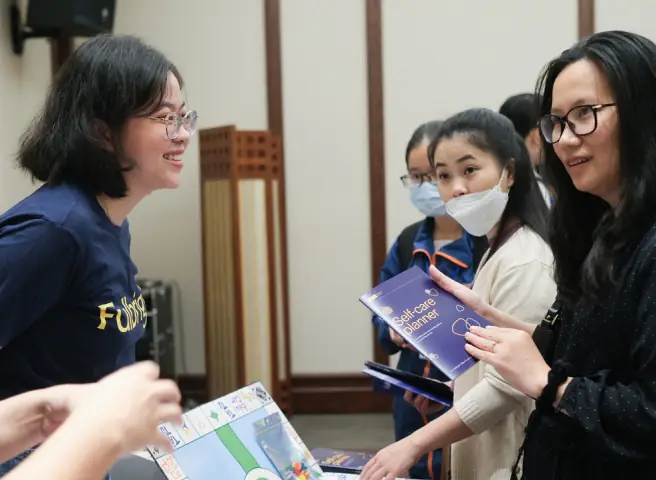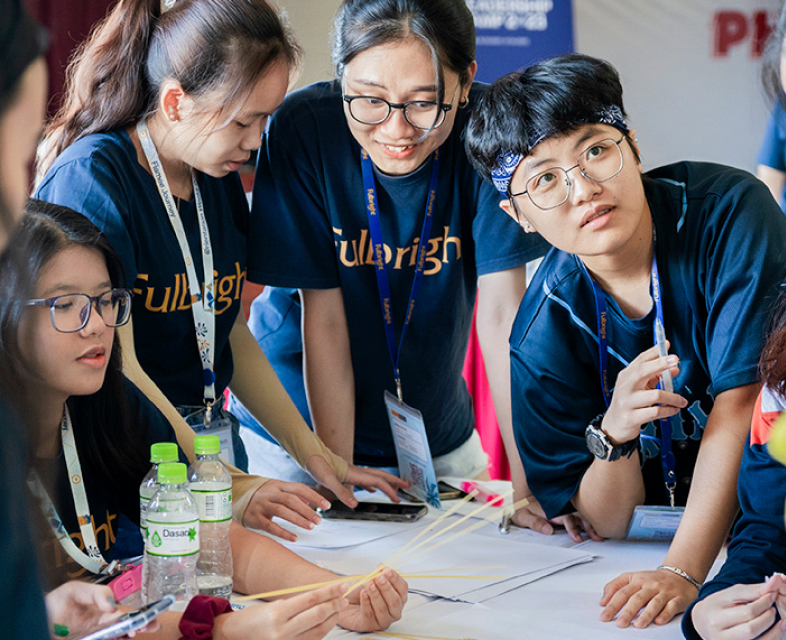
Evan S. Medeiros leads Eurasia Group’s coverage of the Asia-Pacific. Previously, he was senior director for Asian affairs at the White House’s National Security Council (NSC).
Evan served as President Barack Obama’s top advisor on the Asia-Pacific and was responsible for coordinating US policy toward the Asia-Pacific across the areas of diplomacy, defense policy, economic policy, and intelligence affairs.
[/bsf-info-box][vc_column_text]He delivered his speech at Fulbright University Vietnam’s Conference: “US-Vietnam relations under President Donald Trump’s administration” which took place on January 17, 2018 in Ho Chi Minh City.
Friends, colleagues, thank you very much for inviting me. It’s been exactly two years since I’ve been to Vietnam. And in those short two years, definitely there has been change in the wider world; certainly change in the United States; probably change in Asia and, potentially, change in the U.S.-Vietnam relationship. And that’s what I’d like to talk about today. I’ve entitled this talk “U.S-Vietnam relations in the new era and beyond.”
So before I begin my extended presentation on the U.S.-Vietnam relation in the new era and beyond, I’d like to start with a story that hopefully will help capture my views on the future of the relationship. Take yourself back to July 2013. In the morning of July 25 (it was a very bright, very humid morning in Washington), I walked into the Oval Office to brief President Obama.
At that point, I’d been on the National Security Council for four years. I had grown accustomed to just about everything that you’d experience working in the White House: incredible access to people and information; lots of “once in a life time” type of experiences, meeting the Dalai Lama multiple times, of course the very heavy, consequential decisions on national security that you’d make, and of course, simply the relentless pace of working at the National Security Council.
We used to refer to it as a “sprintathon” — in other words, you’re sprinting in a marathon at the same time. But the one thing that you never got used to and certainly I’ve never become jaded about was briefing the President. It was always hard and it always required intensive preparation. It was daunting — I’d always get a pit at the bottom of my stomach the minute I walked in that room.
So on this bright, humid morning, I walk into the Oval Office, and I sit down on the sofa. The way this is configured is two seats in the front — President and Vice President — and then two sofas. So I sat down on the sofa, but the awkward thing is, the sofa in the Oval Office is way too comfortable.
They’re perfect for watching a movie; they’re horrible for briefing. So you sit down on the sofa, and you sort of sink into it — which is not the posture you want if you’re briefing President Obama. Across from me on the other side of the sofa was Penny Pritzker, the Secretary of Commerce, Mike Fromman, US Trade Representative, and Susan Rice, the National Security Adviser. Now they are sitting back; they were looking comfortable, because it was my job to brief the President.
Obama gave me his sort of usual, very intense stare, that was both attentive and distant, and a little bit skeptical. You have to prove yourself in each and every meeting with Obama. So I began by saying Mr. President, today I’ve come to talk about an incredible strategic opportunity for the United States in Asia.And he sort of stopped me, he lifted is head and said, “Evan, everybody walks into this office and brings me problems and crises, so this’d better be good.”
So I proceeded to describe to him about how the upcoming visit of a President from a prominent Asian country would allow us to at once bend the arch of history toward reconciliation, help move the Asia – Pacific past the vestiges of the Cold War ideological competition, help put in place a new set of global rules and norms on trade and investment, that would unleash enormous prosperity, and help to create a strategic environment in the Asia-Pacific, where countries are free from coercion, from rising countries who are exploring the limits of their capabilities.
So Obama said, “Wow that sounds pretty good, what you have in mind.” Of course, I was talking about Vietnam. This was my briefing to President Obama the morning before president Sang arrived in Washington, met President Obama in the Oval Office, and announced for the first time the creation of the US-Vietnam comprehensive partnership.
That was four and a half years ago, and so much has changed since then, and that’s what I’d like to talk about for a few minutes — what has changed, what is the new era, and I’d then like to talk about the “and beyond” part: what might the future hold.
So what is this new era? Well, my conceptualization of this new era has three parts: economics, politics, and geopolitics, and let me talk about each one briefly. But I think it’s important to understand that this new era in US-Vietnam relations is not all about Trump.
Rather, the new era is about broader structural shifts in the world in Asia within both our countries that will directly and indirectly, positively and negatively impact the US-Vietnam relations.
Globally, the world is in the moment where core issues are being debated; global governance, or what constitutes global governance at an international level; state-society relations, the role of the market vs. the role of the state at the national level: these are not ordinary times in international relations. So let me talk about global economics for a minute.
The global economy, trade, investment, finance are evolving in new and important ways, and some of them are being masked by the current period of synchronized global growth and the uptick in global trade.[/vc_column_text][vc_column_text]2017 was a great year for the global economy. There are 4 trends that I’m most focused on in terms of global economics. First, globalization understood as lowering barriers to goods, services, capital ideas, people, is no longer progressing in a linear or rapid manner.
If you were to plot a progress curve of globalization, it is no longer steep and it is no longer linear. Simply put, it’s no longer widely accepted, that reduced barriers to these flows of goods, services, capital, ideas, etc. is universally a good thing for all people and for all countries.
Countries like the United States, and the EU, are actively debating how open they should be. Now it’s very easy for forget in this part of the world, because so many Asian countries like Vietnam have benefitted from globalization and access to developed markets. China loves open markets, just as long as it’s not China’s markets.
And then of course there’s lots of debate about protectionism. That means that economic nationalism is on the rise; trade agreements are going to be more regional than global, and progress on trade and investment liberalization is probably going to decelerate for a few years. Asia may be the exception to that, deeply encouraged by the prospect of TPP 11 or TPP 10, whatever it ends up being—we’ll see, I hope so.
Second, the global economy has not recovered from the global financial crisis. Big and final step in global recovery is just starting. In other words, the withdrawal of quantitative easing programs by the US, the EU, and perhaps Japan. Interest rates may rise. We don’t know how fast, but they’re certainly moving in that direction.
This could be, depending on what market expectations are and how rapidly they rise, depending on whether or not there are exogenous shocks, this could be a volatility-inducing event, if rates start going higher, and of course that affects currencies. This is going to require a very strong national system, and a strong attention to resilience. Simply put, countries with weak banking systems are vulnerable.
Third, China is rapidly emerging as the center of gravity for the global economy, and this carries both upside and downside risks. Xi Jinping has very recently consolidated his power and he’s adopted a robust blueprint of reforms related to financial de-risking, environment protection, policy alleviation, industrial policy, et cetera.
But China is not opening up more at home, and it has a very aggressive strategy for external economic influence: One Belt One Road, AIIB. Chinese outward investment clearly is their big, new economic and political tool. And China is not shy about using its economic linkages for political purpose.
Just ask policy makers in Norway, Taiwan, the Philippines, South Korea, and even Vietnam — countries that have been at the other end of Chinese economic coercion. So as China rises as a center of gravity of the global economy, it’s going to require adjustments for us all.
Fourth and lastly, in terms of global economics, pay attention to the rise of robotics and automation in manufacturing. It’s going to compress supply chains that have been geographically distributed, and it may result in the re-aggregation of production and consumption. And if you remember, the whole idea behind the second phase of globalization was that consumption and production could be dis-aggregated in order to take advantage of low-cost labor. This is going to impact Vietnam, but I don’t know how it’s going to impact Vietnam.
But if China begins on-shoring some of its manufacturing, because it’s now cheaper to hire robots than use labor in other countries, that’s going to change the name of the game. And the question is, as economies like Vietnam seek to move up the value-added ladder in manufacturing, what happens if automation and robotics pull that ladder up before countries like Vietnam can begin climbing? I don’t know the answer to this question, but it’s probably the most important event in global manufacturing and technology in the next ten years.
So let me talk a little bit about politics—global politics—and how it’s going to affect the US-Vietnam relationship. And really, the major development related to politics (and by politics I’m not talking about geopolitics; I’m talking about national-level politics): what’s going on in the political economies of countries all over the world, and the most prominent and important phenomenon to pay attention to is the rise of populism. In other words, the rise of anti-establishment politics.
The rise of popular support for political leaders that come from the outside the established political parties and practices of any country’s political system—its, generally speaking, driven by frustration and alienation, by vocal groups from the political and economic elites in countries all over the world.
This is largely driven by structural economic, and demographic economic trends, but importantly, populism is different in developed and developing countries, and that distinction is relevant to our discussion today about the US-Vietnam relationship.
In the developed markets of the US and the EU, alienation and frustration is largely due to economic shocks, immigration shocks, technology shocks. In other words, people who lost their jobs due to offshoring and manufacturing, automation, and in some places this was made worse by immigration.
The same people who lost their jobs generally feel that the erosion of national boundaries has been a threat to their cultural and national cohesion — that was clearly a very important part of the dynamic that drove the Brexit decision. And it’s these constituencies who feel in their daily lives the economic shocks of losing their jobs to automation or outsourcing—these were the ones that have embraced a sort of anti-establishment politics in the US and the EU.
Whereas populism in developing countries, especially in Asia, is very different, but it’s going to affect us all. It’s not driven by an economic shock; it’s clearly not driven by economic deprivation, but rather, the opposite phenomenon of rising expectations of a young populations searching for a better quality of life. They want more than just jobs and wages—that was good enough, ten or fifteen years ago.
Now what they want is better education, environmental protection, better transportation, better access to health care. They’re online, they’re connected via social media, they’re making their voices heard and they’re prepared to accept, or at least experiment with, politicians from outside of the established political classes.
Look no further than the recent election of Rodrigo Duterte in the Philippines, Jokowi in Indonesia, Aung San Suu Kyi in Myanmar. Some leaders get this, and I think that’s in part what’s driving this intensive, embracing anti-corruption trends across Asia, India, China, even here in Vietnam.
Because some leaders recognize that these populations who are demanding a better quality of life also want greater accountability and greater transparency from their government. Anti-corruption is one way to get at that. And I believe that these phenomena are alive and well in Vietnam.
They don’t threaten regime security, but they’re certainly changing state-society relations and the political economy of Vietnam. When I look at the [fish kill] incident in 2016, I think is a clear indication of this desire for accountability and transparency from the young population, expecting more from the government.
The third and last element of the new era in the US-Vietnam relations is geopolitics. And let me make a few points here. First, the most obvious change in global politics in the last few years is the United States. Simply put, with the election of Donald Trump, the US’ role is uncertain. Trump may represent a very sharp break from seven decades of US support for international order based on commonly held rules, norms, and institutions.
At best, Trump is ambivalent about the so-called liberal international order. But keep in mind that fundamentally, the US right now is really focused on domestic issues, hence the focused on the trade deficit as opposed to more legitimate measures of bilateral trade relations. The United States went through a periods like this in the 1970s and perhaps we’re living it once again. But I think we simply have to get used to the fact that the US is going to be a source of uncertainty, more than predictability, in the coming years.
Second, China. It’s an obvious point, but it’s an important one to make. Which is, under Xi Jinping, China is rising in new and different ways. Economically, its external economic footprint will expand and deepen. China is now using its export of capital as the major tool to accomplish both its political and its economic objectives.
Diplomatically, China has moved far beyond Deng Xiaoping. Gone are the days of keeping a low profile. Xi Jinping in his speech at the 19th Party Congress had a very important line in there, where he started talking about “the China option,” “the China alternative.” And the question is how much resonance is there going to be for this in other parts of the world. Militarily, China’s presence in Asia is substantial and growing.
Within ten years, there will be four Chinese aircraft carriers operating in the Western Pacific, twice the number of submarines. By 2020, the Chinese navy will have doubled from its size in 2010. This is going to change our strategic environment.
And now importantly, the Chinese see enormous strategic opportunity before them. They see the election of Donald Trump and everything that came with it as a huge opportunity for them to step forward. Look no further than a major and very high-profile editorial in the People’s Daily yesterday, that talked about the historic opportunities presented by these so-called “democratic deficit” all over the world to expand Chinese global influence. Under Xi, this will be a very different China challenge that we face.
Third geopolitical trend: North Korea. The future of the Korean peninsular will be the next major threshold event in Asia’s geopolitics. This is the moment that will define what we define power relationships among all the great powers. The ripple effect on ASEAN will be substantial. It could be a re-ordering moment for geopolitics in Asia. We simply cannot rule out the possibility of major power conflict on the Korean Peninsula.
Fourth and lastly, we all need to be prepared for a new era in US-China relationship. It’s going to be defined by tensions, friction, and consistent competition. US frustration and anxiety with China are hitting new levels in the United States. Look at the language of the national security strategy: “expect the new baseline for higher and more intensive frictions in the US-China relationship.”
Now, US tolerance for this level of friction and tension in the relationship is untested. It’s unclear how much tolerance there will be in Washington for this kind of relationship with China.
But what that means is Asia, even ASEAN, will become a crucible of major power competition in a multilateral world, even more than it is today. Is Vietnam aware of this trend line, and is it ready for what this means? And that’s where I’d like to turn now, the future of the US-Vietnam relationship.
I see many possible trajectories for the relationship. And Ambassador Kritenbrink was very eloquent this morning about the robust agenda for the US-Vietnam relationship. I fully agree. It’s a robust agenda, it’s a deep agenda, and Fulbright University is a perfect example of what can be done.
When I spoke in HCMC in this very hotel two years ago, I talked about the untapped and enormous potential in the US-Vietnam relationship.
I used the metaphor of a “glass ceiling” to describe my view of our collective future. At once we can see the possibilities, but we can’t always reach them in a timely manner but because of a variety of political, ideological, strategic barriers on both sides — I’m not blaming one side or the other, it’s just the nature of the relationship.
Hence the glass ceiling. And I still think that this is an apt metaphor. But in the last two years, and really in the last year, I’ve come to believe that there’s another appropriate image to describe the relationship: the glass floor. What do I mean by that?
Well, I mean we both are worried about the foundation of the relationship under our feet; how strong and enduring is it, and will it break, or at least crack, and undermine our respective national interests if we put too much weight on it too fast. So we hedge our bets about each other. My sense is that this feeling may be stronger in Vietnam than in the United States.
So when I think about the US-Vietnam relationship, and this “glass floor” constraint, there are really two issues that come to mind.
The first is the issue of uncertainty, and the second is the issue of balance. These two ideas, uncertainty and balance, are central to how we both think about the other in the future of this relationship, and we need to understand what both need, and the role that they play, if we’re going to ever enjoy the potential of the relationship. So please indulge me for a moment in discussing each one of these ideas.
On uncertainty, first and foremost, American strategists and policy-makers focused on Asia understand Vietnam’s strategic predicament and strategic imperatives. You’re fiercely independent, and want to maintain your strategic autonomy.
You don’t want to choose between or among partners. You’re searching for leverage in much of what you do, with us and with other countries, and we respect these imperatives, and believe that there is ample room within them for US-Vietnam cooperation.
So when it comes to your uncertainty about American strategic intentions, we get it. We understand that our staying power, especially now, looks a little bit unpredictable. This concern is obviously acute now under a new president with the withdrawal of TPP, Paris, and broader questions about our commitment to the liberal international order. But let me suggest you think about uncertainty in a few different ways.
First, the United States can never provide the kind of certainty you want, absent an alliance. In other words, uncertainty is an issue to be managed in a relationship, and shouldn’t be seen as a barrier to progress.
Second, look at the overwhelming consistency of U.S. foreign and national security strategy over the last seventy years, especially after the Cold War, to the Asia-Pacific. Look at how America define its strategic interests: they’re remarkably consistent and very bi-partisan when it comes to the Asia-Pacific. Certain strategic realities, like China’s rise, are not going away; they’re only intensifying.
Third, let’s use uncertainty as a positive force in US-Vietnam relationship; use it to drive toward more cooperation, more communication, more interaction, and to build a deeply institutionalized relationship. Only this kind of effort can reduce uncertainty.
Fourth, let’s both take action and let’s experiment. But let’s not go too slow, because that might generate a little resentment. Look at what the Obama administration did between 2013 and 2016 — it’s substantial in most areas. In those three years from the beginning of the Comprehensive Partnership to welcoming your General Secretary to the Oval office, it’s remarkable what was accomplished in 3 short years—and of course, President Obama’s trip here in 2016.
Fifth and lastly, on the issue of uncertainty, people-to-people ties have to be part of it; it is essential, it is fundamental. And that comes from sort of a hard-core policy maker in the very heights of the national security council. Only through deeply institutionalized, deeply rooted connections at all levels of society can we really eliminate uncertainty.
Second, let me talk about balance. I think both sides constantly engage in a struggle to balance US-Vietnam relations with their other strategic interests. Usually, this means China. Not always, but usually. So here’s the issue with balance. We both need it, we both seek it, we both know the other needs it and seeks it, but sometimes one side needs it a little bit more than the other. Or at least they think they do.
So let me be very clear. The United States does not, and should not, want Vietnam or any country in Southeast Asia to choose between the United States and China. US policy toward Vietnam, the heart and the core of the Comprehensive Partnership (and I know because I negotiated it) was an explicit understanding that no fundamental choice existed for Vietnam. We were offering the freedom not to choose.
But we need to be careful. Because that quest for balance does not become an overall constraint for expanding our bilateral relationship. Collectively, balance has to provide direction and momentum to the relationship. So clearly, this is going to be a challenge to both sides.
Friends and colleagues, in closing, I would like to go back to the story that I began my speech with, take you back to the Oval Office in July of 2013. After briefing Obama for about an hour, everybody gave their presentations, and Obama said to me, “Okay, Evan, great. I think we are all set for President Sang. Is there anything else?”
And I said, “No.” So I started to put my materials together, and he turned to me and said, “Evan, I think it is important for me to let them know that we respect them. We respect their sacrifices, their accomplishments, Vietnam’s choices, and the risks in getting closer with us.” I said, “Mr. President, that’s exactly right.”
I knew at that moment, that I had an opening, and the next big step was getting the General Secretary into the Oval Office as the ultimate sign of respect. And you all know how that story ends. Thank you very much.







